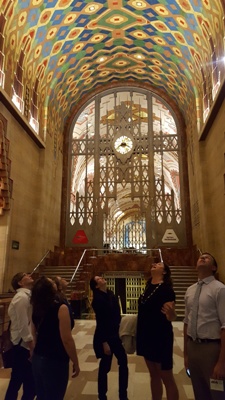
Plan your visit
STAY CURIOUS, MY FRIENDS
September 23, 2016

In September, the Local History Services team attended the 2016 American Association for State and Local History (AASLH) annual conference in Detroit. We had the opportunity to spend time with our Field Services colleagues, reconnect and network with museum professionals from all over the country, see Detroit’s amazing architecture and museums, and find out about current issues in the field. And, of course, the conference was a chance for us to indulge our love of learning.
In Local History Services, we spend a lot of time preparing training materials, presenting workshops, and sharing resources, but we also believe that you should never stop learning. We take every opportunity to learn new things about the museum and history professions, from reading articles to attending training classes. So, when we attend AASLH conference, we always jump at the chance to go to sessions that might teach us something new. Here’s a snippet of what we each took away from the experience:
In a session titled Life after Rebranding, I learned that there are three basic types of brand architecture and that each type should be considered when an organization is thinking of rebranding. Monolithic = one brand with one name; endorsed = sub-brands linked to the original brand; and freestanding = original brand acts as a holding company. Organizations, especially older ones, may have any combination of brands and names that they have used and may be still using. All of the brands need to be considered. Some may change and some may be grandfathered into the new brand with additions/modification to the logo, name and tagline. Tamara Hemmerlein, director, IHS Local History Services
I learned about the Dorothy A. Johnson Center for Philanthropy at Grand Valley State University as a resource focusing on fundraising for smaller organizations. The IRS public support test differentiates private, independent foundations from public charities. Private, independent charities operate based on income from one source (endowment) and do not actively raise funds. Public charities are actively engaged in both raising and distributing funds. Also, the five percent spend-out requirement for foundations is based on a rolling five-year average determined by the market. Current philanthropy trends: decrease in pilot programs to be picked up and scaled by government; increase in place-based philanthropy; and an increase in building networks to address problems. Jamie Simek, fundraising educator, IHS Local History Services
One issue that can be difficult for nonprofit organizations is that of leadership transition, so I attended a session called Passing the Torch to learn more about how succession planning can be handled well. I learned that a gradual transition in leadership is ideal, and that the process should involve transparency, trust and the passing of institutional memory. In addition, the organization should be put first, above any egos or personal ambitions. Finally, there should be a cohesive message throughout the process, open communication, continuing professional development and additional funds set aside for staffing changes. Jeannette Rooney, assistant director, IHS Local History Services.
At a session on interpreting female friendships, it was very nice to really stop and think about how our 20th/21st century biases and understandings of the present can reflect on what we see and read in the past. There was quite a bit of discussion about understanding the world in which events actually took place and identifying your own biases so you can readily recognize when they are creeping into historical fact. As museums, it is important to think about this because our visitors will come in with biases and we need to a) recognize what they might be and b) understand how to help the visitor learn about the historical fact with as little bias as possible. Karen DePauw, coordinator, IHS Local History Services.
No matter what part of the museum or history fields you work in, whether you are a conservator, administrator, director, curator, fundraiser or marketer, it is important to keep learning about the field, even outside your chosen area of expertise. The more we learn, the more we can continue to add benefit to ourselves, the profession and our visitors. Stay curious!








